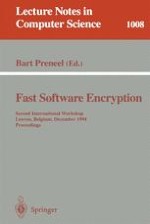This book contains a set of revised refereed papers selected from the presentations at the Second International Workshop on Fast Software Encryption held in Leuven, Belgium, in December 1994.
The 28 papers presented significantly advance the state of the art of software algorithms for two cryptographic primitives requiring very high speeds, namely encryption algorithms and hash functions: this volume contains six proposals for new ciphers as well as new results on the security of the new proposals. In addition, there is an introductory overview by the volume editor. The papers are organized in several sections on stream ciphers and block ciphers; other papers deal with new algorithms and protocols or other recent results.
